on Audi Rickshaws. . .Michelin and Hyundai and Tires. . .Levels of Trust. . .Tech for an Autonomous Fighting Vehicle. . .What's American Made & More
What is Audi doing in India with rickshaws and e-tron batteries. . .BEVs and diesels in Europe. . .Tires. . .Trust. . .Autonomous fighting vehicle. . .VW GTI. . .American-made vehicles. . .and more
Second Life for Audi EV Batteries
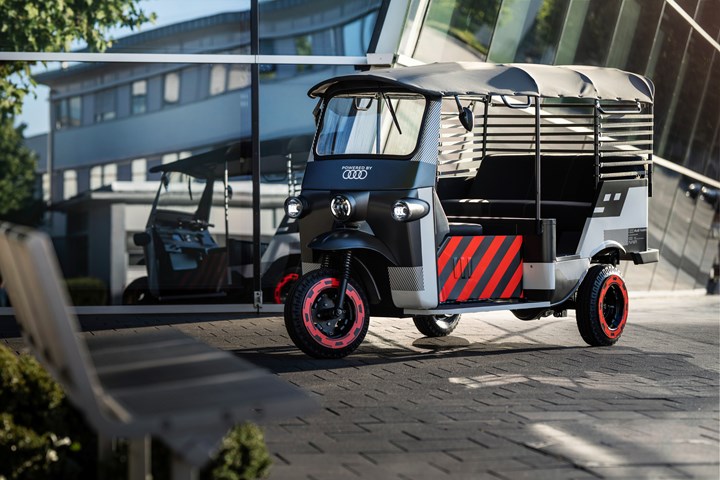
Not what you might think of when “Audi” comes to mind. (Image: Audi)
“Nearly 10% of global car sales were electric in 2021, four times the market share in 2019. This brought the total number of electric cars on the world’s roads to about 16.5 million, triple the amount in 2018. Global sales of electric cars have kept rising strongly in 2022, with 2 million sold in the first quarter, up 75% from the same period in 2021.”
That’s from the IEA’s “Global EV Outlook 2022.”
As is well known, EV batteries tend to become decreasingly useful for automotive applications over time. So OEMs and other organizations are looking for second-life applications, generally stationary power (e.g., storing renewable power for use when the wind isn’t blowing or the sun shining).
While it might not be a huge issue now, given the ramp up in global EV deployment as indicated by those IEA numbers, reuse (and recycling) cannot be overlooked.
This is different
The Audi Environmental Foundation is working with a non-profit German-Indian startup, Nunam, to determine the viability of reusing the batteries for electric rickshaws.
The batteries for the pilot project, commencing next year in India, come from Audi e-tron test vehicles.
Prodip Catterjee, Nunam co-founder, says, “In our second-life project, we reuse batteries from electric cars in electric vehicles; you might call it electric mobility ‘lite’. In this way, we’re trying to find out how much power the batteries can still provide in this demanding use case.”
Tapping the trainees
In addition to the foundation, AUDI AG, as in the vehicle manufacturer of the e-tron and other autos, is involved in the project, too.
Twelve trainees at the Audi facility in Neckarsulm, Germany, are working on developing the e-rickshaws.
Timo Engler, head of automotive engineering/logistics training in Neckarsulm, says, “The trainees and Nunam are in constant communication with each other – we have a dedicated line between Neckarsulm and Bangalore.”
One of the models they’ve developed, Engler says, has “Audi’s DNA.”
Benefits for the people
Not only is the pilot focused on helping people in India—Chatterjee: “Women in particular will be able to use the all-electric rickshaws to transport their goods to market for sale, all without the need for intermediaries”—there is a benefit to Audi.
Engler:
“To us, it’s important that the trainees are involved in the project from start to finish and are given the freedom to contribute and try out their own ideas. ‘Learning by doing’ is our recipe for success. At the same time, we impart fundamental knowledge in the development of electromobility, resource efficiency, and charging technologies in an almost playful, incidental way. It’s a groundbreaking project because it combines the megatrends of sustainability, electromobility, internationalization, and social responsibility.”
While a three-wheeler is a long way from an e-tron, not only will the people in India benefit, so will Audi personnel.
///
Powertrain Pop Quiz
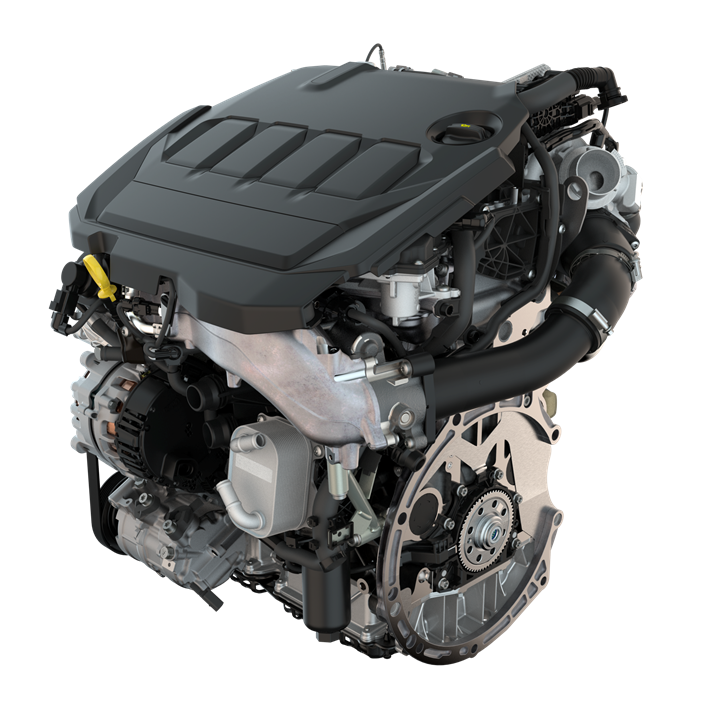
VW 2.0 TDI diesel engine. (Image: Volkswagen)
LMC Automotive has run the numbers for powertrain deployment in the Western European market. It has the 2021 numbers and projects the numbers for 2022.
Here’s the quiz:
In 2021 the diesel car market in Western Europe was 2.8 million vehicles. What will it be in 2022:
- 1.8 million
- 2.0 million
- 2.3 million
- 2.4 million
In 2021 the battery electric vehicle sales in the region were 1.2 million vehicles. What will they be in 2022:
- 1.1 million
- 1.3 million
- 1.6 million
- 1.7 million
Scroll down to get your answers
///
Hyundai & Michelin Partner to Drive Tire Tech for EVs
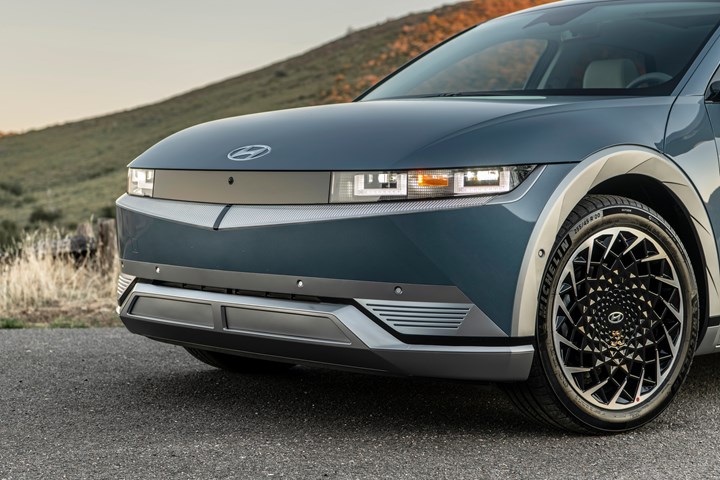
The tires on the IONIQ 5 were developed by Michelin and Hyundai as part of a five-year agreement the two companies signed in 2017. (Image: Hyundai)
Hyundai Motor Group and Michelin have signed a memorandum of understanding (MoU), a three-year-long follow-up to an agreement signed in November 2017. That one led to the development of a tire for use on the IONIQ 5 electric vehicle.
This new MoU will focus on the development of “next-generation tires” for future Hyundai Motor Group (as in the Hyundai, Kia and Genesis brands) vehicles.
Areas of focus:
- Tire wear
- Tire load
- Road friction
Another element is using an increased amount of eco-friendly materials in tires, going from the present 20% to 50% of total tire weight.
The companies are also working toward developing a real-time tire monitoring system that will be also used in autonomous driving applications.
After all, who wants a flat when there’s no driver on board to fix it?
///
The Trust Gap
Remember how Garrison Keillor would end the opening monologue in “A Prairie Home Companion”:
“That’s the news from Lake Wobegon, where all the women are strong, all the men are good-looking, and all the children are above average.”
That comes to mind when looking a one finding of the PwC 2022 Consumer Intelligence Series Survey on Trust in terms of how corporate leaders see themselves. Especially the part about the children.
PwC found:
- 87% of executives surveyed think consumers “highly trust” their companies.
In reality:
- 30% of consumers “highly trust” those companies.
A 57-point trust gap.
Things are somewhat better internally:
- 84% of business leaders think their employees highly trust their companies.
- 69% of employees highly trust the companies they work for.
That’s a 15-point delta.
On a more granular basis, these findings ought to give pause to company execs.
- 51% of execs and 41% of employees strongly agree with “Trust is a leading priority at my organization.”
- 49% of execs and 41% of employees strongly agree with “My organization understands the value of employee trust.”
- 47% of execs and 35% of employees strongly agree with “Trust today is more bottom-up than top down.”
That last one probably goes a long way to explaining why there is something of a disconnect regarding organizational trust.
///
Level 5 Military Vehicle
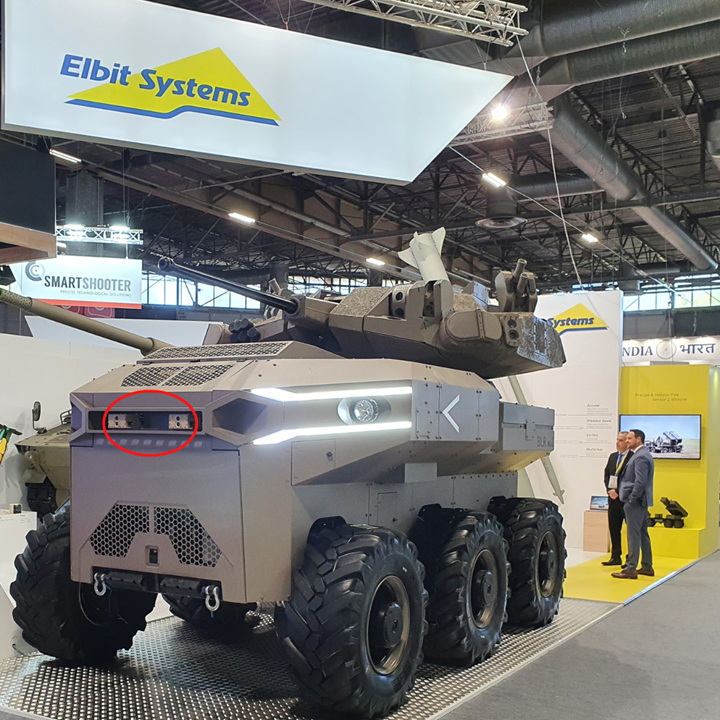
The red oval indicates the location of the Elbit visible-light and thermal cameras, which are using Foresight QuadSight software. (Image: Foresight)
Not all autonomous robotic vehicles have smiley faces on them and things like ice cream and pizza inside.
At last week’s Eurosatory Defense and Security Exhibition in Paris, a robotic unmanned vehicle, developed by the Israel Ministry of Defense’s Directorate of Defense Research and Development, the Tank and APC Directorate, and Israeli security industries, was exhibited in the booth of Elbit Systems, which “operates in the areas of aerospace, land and naval systems, command, control, communications, computers, intelligence surveillance and reconnaissance (‘C4ISR’), unmanned aircraft systems, advanced electro-optics, electro-optic space systems, EW suites, signal intelligence systems, data links and communications systems, radios, cyber-based systems and munitions.”
Yes, a serious outfit.
The Tech
The vehicle features things ranging from a 30-mm autonomous turret to a drone that is launched from a robotic arm.
It also has a multispectral vision system. It uses QuadSight, from Foresight, which facilitates autonomous driving in all-terrain situations (motoring in war zones has its own set of challenges that your local motorway is without). The system was developed by Foresight and Elbit.
The Israel Ministry of Defense will be putting the fully autonomous vehicle into field tests starting in 2023.
(If you think watching Boston Dynamics robots is disconcerting, take a look at this.)
However. . .
In a more conventional development space (at least in terms of ADAS as you might think about it), Foresight won the ZF Pitch Event held at the 2022 CES in January. The two companies have just signed an agreement for a joint proof-of-concept project.
Wondering what this entails, we asked ZF.
Marc Bolitho, senior vice president Engineering, ZF Electronics and ADAS division, answers:
“The Proof of Concept project consists of technological evaluation and testing of predefined simulated and real-life scenarios. Foresight intends to demonstrate its ability to create a stereo pair using ZF’s existing camera technologies The new stereo solution provides a rich perception based on enhanced 3D depth mapping, accurate distance measurement and object detection. Foresight’s proprietary Mono2Stereo software-based solution, which is evaluated in this project, uses existing mono cameras to create a 3D perception stereo vision solution to improve the overall probability of detection of existing ADAS systems.”
In this case, for applications where the vehicles aren’t under attack.
///
2022 Volkswagen Golf GTI 2.0T S
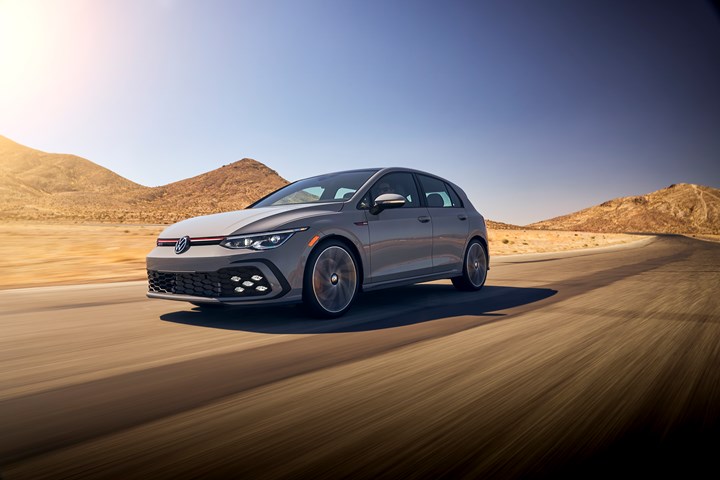
‘22 VW GTI: That would be a great road to be able to drive that can on. (Image: Volkswagen)
When Volkswagen of America reported its Q1 2022 sales it noted the overall number was down 28.5% compared with the same period in 2021 but that SUVs accounted for 76% of sales in quarter, as in the Tiguan, Atlases and Taos.
The GTI, however, was down 41% compared to the Q1 ’21, or a total sales of 1,543 in Q1 ’22.
Which is, on the one hand understandable (who buys a hatch powered by a 241 hp, 273 lb-ft of torque, turbocharged, direct-injection engine?), but on the other hand inexplicable (the VW SUVs are certainly good vehicles, but select the “Sport” drive mode in the GTI and, assuming that you’re driving one with a seven-speed dual clutch transmission (DSG), you depress the accelerator and become immediately cheerful as you are pushed back into the bolstered seats covered with a gray and black plaid fabric).
Credit to VW for continuing to provide a car in this market that is fun-to-drive and somewhat functional (e.g., it offers 19.9 cubic feet of cargo with the rear seat up and 34.5 cubic feet with it down, so there’s ample room for one’s stuff—not in SUV territory, but still good for a vehicle that is 168.8 inches long, 70.4 inches wide and 57.6 inches high) even though its not a big seller.
(While the world seems to be going SUV, there are still enthusiasts of hot hatches.)
Solid
One of the things that VW gets absolutely right with the vehicle is that even though it is small and reasonably light (3,113 pounds, curb weight), it has a solid structure so when you get on the accelerator you don’t have a sense that there is Jell-O involved in the assembly of the chassis.
Rather, the vehicle is constructed with the extensive use of high-strength, hot-stamped steels and processes like laser welding are used to assure that components come together in a solid manner. (To the point of mass: in addition to the use of ultra-high-strength steel, which allows lighter weight components, there is the use of aluminum for the subframe used in the front suspension setup, which cuts about seven pounds.) There is no unsettling give when it goes into a corner.
Connections
The S trim level comes with what is called the “Composition Color MIB3” infotainment system with a 8.25-inch display. While there are Apple CarPlay and Android Auto, Apple users may be a bit surprised to discover that the vehicle has USB-C ports in the center console, so the appropriate connector is necessary although (1) there is Bluetooth to pair with the system and (2) there is wireless charging capability, but for those iPhone users who are in the backseat and need a charge, know that it is USB-C (just think: VW was ahead of the EU, which just mandated USB-C for phones starting in Q4 2024, which undoubtedly miffed Apple).
The Golf GTI is a great reminder that cars are enjoyable to drive without having to break the bank (i.e., starting MSRP for the S trim is $29,880).
And speaking of the bank, it is worth knowing that the car has EPA-estimated fuel economy of 25 mpg city, 34 mpg highway and 28 mpg combined, so nowadays. . . .
///
No Static
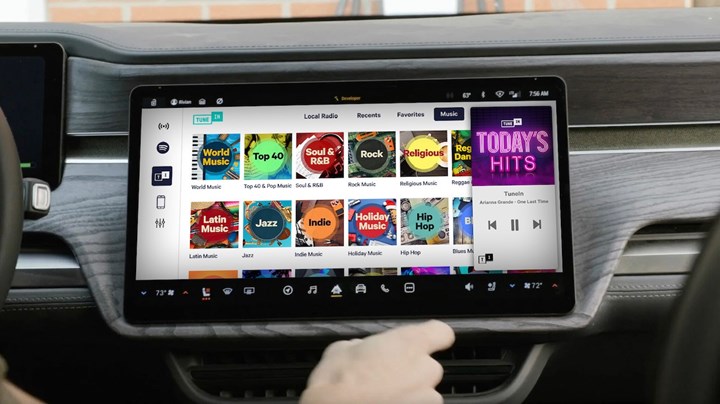
TuneIn comes to Rivian. (Image: TuneIn)
A colleague, who is both a personal and professional automotive enthusiast, is somewhat disconcerted by the increase in the number of electric vehicles—but not for a reason you might think.
One of the characteristics of electric motors such as those used in Teslas, Audis and others is that they generate electromagnetic frequencies. Those frequencies interfere with AM radio. As in static or bad signal quality.
Consequently, those EV OEMs, as well as others, have deleted AM radio tuners from their vehicles.
My friend is the automotive reporter for the Detroit all-news stations.
So there is a potential inverse correlation between the number of EVs on the road and the numbers in his mobile audience. Not good.
Last week EV maker Rivian joined Mercedes, Volvo and Tesla in partnering with TuneIn.
A streaming service.
Lots of connectivity
The folks from TuneIn cite a study from Edison Research, “Infinite Dial,” that has it than 70% of new vehicles will have connectivity by 2023.
That study also shows that when it comes to online audio brand awareness, Pandora (83%), Spotify (76%) and iHeartRadio and Apple Music (both 72%) dominate.
TuneIn? At 16% (along with Radio.com).
Presumably the implementation in the aforementioned vehicles will help.
What makes it somewhat different is that it seems to focus on infotaiment, as in >100,000 global radio stations and podcasts, as well as (for the non-free tier) lots of sports, versus music.
Unfortunately for my friend, his station isn’t one of the offerings.
Ask yourself:
Will AM radio become the next vinyl?
///
Plan to Charge New Rivians
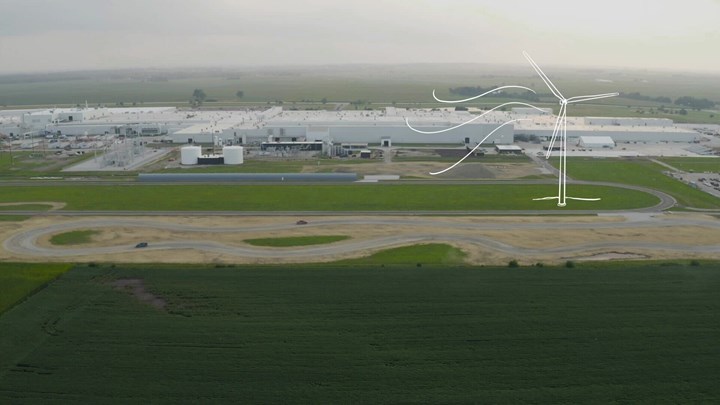
An illustration of where Rivian would like to construct a wind turbine at its assembly plant in Illinois to charge the vehicles coming off the line. (Image: Rivian)
Speaking of Rivian. . .
As anyone who has read David Foster Wallace’s “Derivative Sport in Tornado Alley” (“Wind, wind etc. etc.”)—or who lives in central Illinois—knows, it can be rather windy in that area.
So it isn’t entirely surprising that Rivian, which has its factory in Normal, Illinois, which is smack, dab in the middle of the state, is hoping to erect a wind turbine on its site that will be capable of generating ~10-million kilowatt hours of electricity per year.
“To us, our job isn’t done when our vehicles come off the line. While we’re working hard to help electrify transportation, we’re also pushing to accelerate the shift to carbon-free electricity for all. This wind turbine is an early step on that path, and it’s also a beacon of our vision for a clean energy future.”--Andrew Peterman, Rivian Director of Renewable Energy
Whether the turbine--<510 feet tall with white, non-reflective blades and a maximum sound output of 42 decibels—will be built inside the Rivan test track or not will be soon determined by the Normal Town Planning Commission.
And if they get the green light the use will be:
To give the vehicles produced in the factory their first full charge before delivery to customers.
Here’s something to consider: Normal is 118 miles, as the proverbial crow flies, southwest of the Windy City.
Yes, plenty of wind in Illinois.
///
Powertrain Pop Quiz: The Answer
Diesel: The number of diesels expected to be sold in Western Europe in 2022:
- 2.0 million units
That’s down from 2.8 million in 2021.
Battery electric: The number expected to be sold there in 2022:
- 1.6 million vehicles
It is notable that diesel sales continue to eclipse those of BEVs.
However. . . LMC Auto expects that there will be a flip in 2023 so that instead of being behind by 400,000 units, BEVs will be ahead of diesels by the same number.
///
Tesla and Honda Rhyme
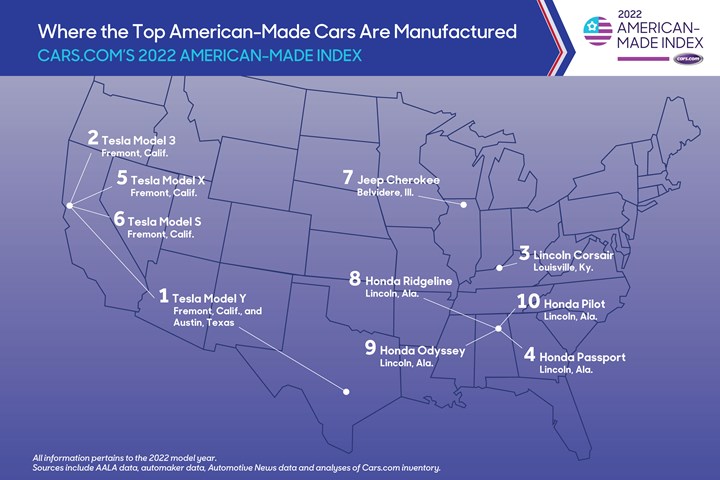
Although California and Alabama dominate the top 10, turns out that the greatest amount of manufacturing related to the American Made Index is performed in Michigan. (Image: Cars.com)
In addition to rhyming, Tesla and Honda also dominate the top 10 of the Cars.com annual American Made Index.
As in:
- Tesla takes the first (Model Y), second (Model 3), fifth (Model X) and sixth (Model S) spots
- Honda takes fourth (Passport), eighth (Ridgeline), ninth (Odyssey) and tenth (Pilot)
Cars.com calculates the American made-ness predicated on:
- Assembly location
- Parts sourcing (based on the American Automobile Labeling Act)
- U.S. factory employment relative to vehicle production
- Engine souring
- Transmission sourcing
Third? Lincoln Corsair.
Seventh? Jeep Cherokee.
Fun facts according to the Index
- 379 vehicles were available in the U.S. market
- 95 of those vehicles made the Index
- States with the greatest amount of sourcing, production and assembly: Michigan (15%), Ohio (12%), Indiana (12%), Alabama (12%) and Tennessee (11%)
- The Teslas were made in Fremont, California, and some Model Ys in Austin, Texas
- All of the Hondas were produced in Lincoln, Alabama
- GM vehicles account for 19% of all of the vehicles on the Index, Honda 14%, Toyota 12% and Ford 12%
Does it matter?
An increasing number of Americans are interested in buying American.
Jenni Newman, Cars.com editor-in-chief, says they found there is “consumers’ renewed interest in supporting the local economy, with 40% of car shoppers saying that buying a car built in America is now more important to them, up 22% year-over-year.”
Think about this
According to Experian registration numbers, in Q1 2022 there were 113,882 Teslas registered in the U.S.
The Q1 sales of all of the other vehicles in the top 10—Honda, 54,862; Jeep, 10.079; Lincoln, 6,944—sums to 71,885 vehicles. Just 63% of the Tesla number.
Tesla builds a lot of American vehicles.
RELATED CONTENT
-
Plastics: The Tortoise and the Hare
Plastic may not be in the news as much as some automotive materials these days, but its gram-by-gram assimilation could accelerate dramatically.
-
Cobots: 14 Things You Need to Know
What jobs do cobots do well? How is a cobot programmed? What’s the ROI? We asked these questions and more to four of the leading suppliers of cobots.
-
When Automated Production Turning is the Low-Cost Option
For the right parts, or families of parts, an automated CNC turning cell is simply the least expensive way to produce high-quality parts. Here’s why.


.jpg;width=70;height=70;mode=crop)






